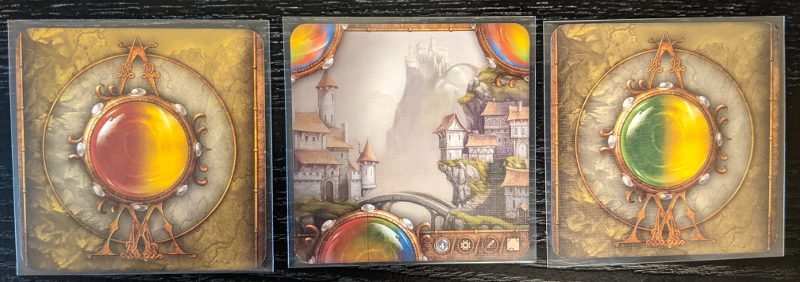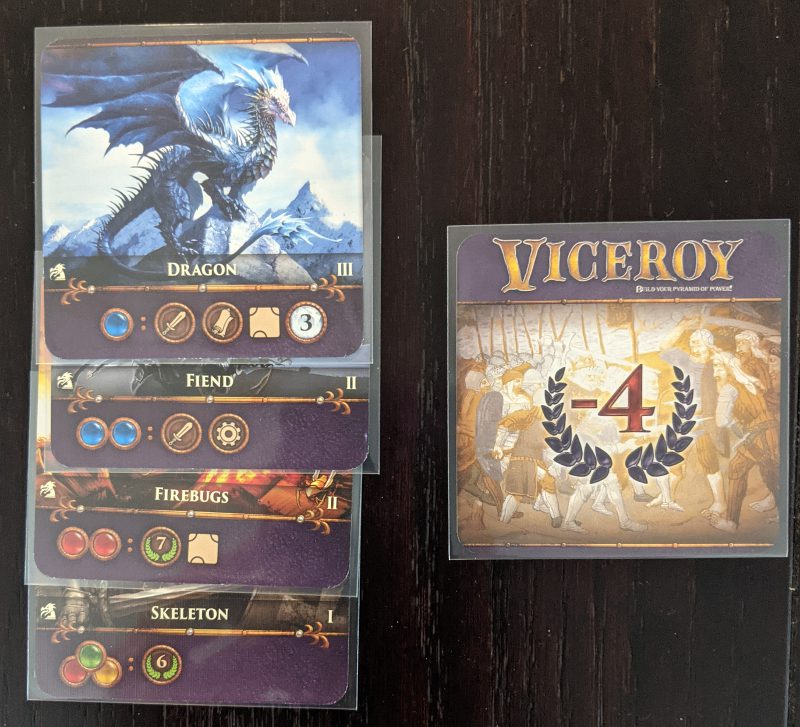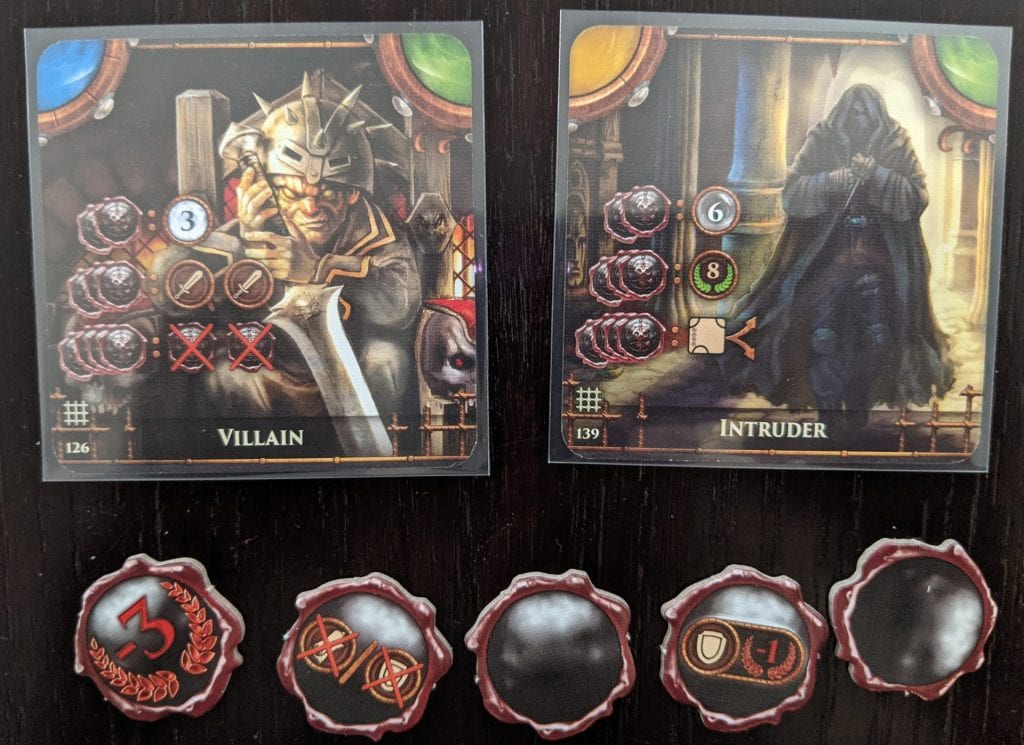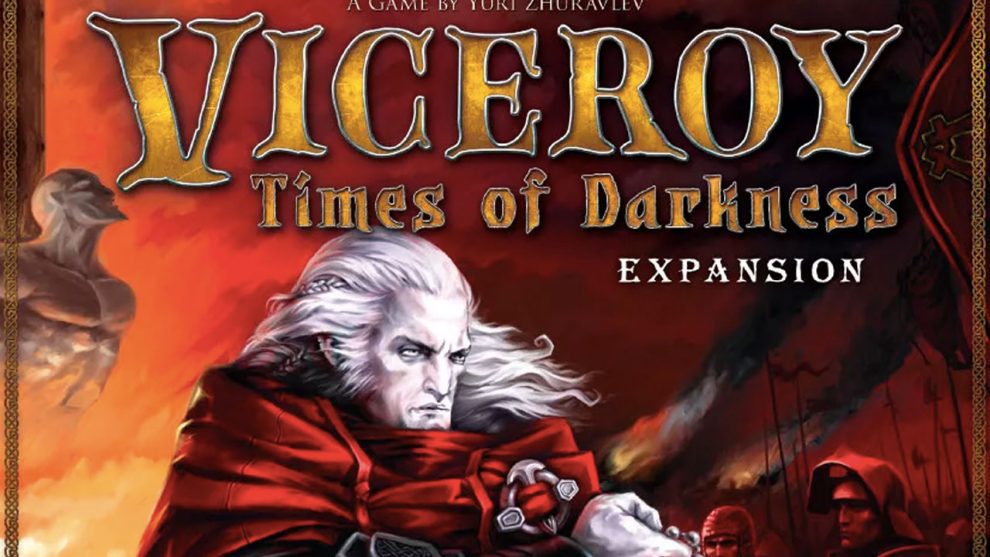Disclosure: Meeple Mountain received a free copy of this product in exchange for an honest, unbiased review. This review is not intended to be an endorsement.
In my extensive review of Viceroy, I praised the fascinating use of a pyramid system to craft your path to earning points. It is a game that I felt deserves more attention. I also pointed out that while I think the game is brilliant, it wasn’t perfect. Playing a two-player game was a pitiful experience resulting in balance issues with some Law cards. It is a game with good intentions that just needed a push in the right direction. Several years later, the Times of Darkness expansion with its three modules isn’t a mere push; it’s a shove into the spotlight Viceroy deserves.
Basement Renovations
The first thing you’ll notice when opening the rulebook are the new components which replace some of the old base game material. There are now two Auction cards for the two-player mode. These two cards force the Auction system to have two character cards instead of four, allowing more discussion and clashing. For the sake of transparency, most of my plays were two-player, and I can say with confidence that Viceroy now works in all player counts. Good stuff.
A second significant change involves the four redesigned Law cards. They replace four Law cards in the base set, buffing the weaker cards and subduing the more powerful ones. Again, this is a welcome change.
The third and final change are the Domain cards. These are now your starting card in your pyramid instead of a random character card. The circles are wild colors, and you get to pick one out of four starting rewards, such as four additional gemstones or a science token. This cleans up the issue of starting imbalances from the base game.
Besides the base game replacements, this expansion also has three modules of your choice along with diamonds that you can mix and match with. Diamonds are a new type of currency and act as a “wild” during Auctions and Development. I’m usually wary of module expansions since they set off a red flag for me. But I was compelled to give this one a shot.

Appeasing the Uptight
Let’s start with the lightest expansion out of the trio: Aristocrats. Shuffle the 12 new character cards with the rest of the character deck. Like any other aristocrat, these boys and girls seek power and want to be placed as high as they can on your pyramid. To emphasize this point, sticking these aristocrats at level 1 yields rewards. Another trait is their bottom circle. Instead of a color, they now grant you new abilities or end-game scoring conditions. It is a hybrid mix of a character card and a Law card. Since the circle is no longer colored, you can’t score or paint with them.
One of the great joys of Viceroy is finding the right character to fit into your pyramid and not ruin yourself financially. To do this well, you need to account for your gemstone stash, negotiate with your friends, and maneuver around the Auction system. Being sloppy with your pyramid by mismatching every circle will yield poor scoring results. Several Viceroys’ greatest strengths are undermined by the Aristocrat cards, resulting in too many cut branches from the decision tree.
Since there are only a few Aristocrat cards, one appearing in an Auction wipes out the value of all the rest. When you do get them, putting them in your pyramid isn’t a challenge either. Since they “ruin” the bottom circle, you aren’t concerned about the position as you normally would be. It may seem like a major sacrifice, but the Aristocrat rewards often outweigh a regular colored circle. Because of this, the engagement here is remarkably similar to deploying a quick fart during your 9-to-5. This one goes into the “nope” pile for me.

For The Hoard
Fortunately, the Invasion module is several stratosphere layers above the Aristocrats module. Included in the Auction deck are monster cards, and you’ll start with one monster in a separate stack. At the end of every Auction round, you add a new Monster card on top of the stack. Once there are four monsters in the stack, you will fend off the invasion after the Development phase.
However, the word “fend” is a strong one here since you’re simply spending your gems. Every monster card has a cost and rewards, similar to character cards. A higher level reward requires you to spend more gems starting from the bottom monster and working your way up. If you cannot afford the bottom monster card, you get negative four points. To make it a bit easier, you have a battle card. Whenever there is an Auction clash, the gems go onto your battle card instead of discarding them, allowing you to use these gems exclusively to fight off the invasion.
As a result, the Invasion module essentially functions as a taxation system, but with monsters far less threatening than the IRS. There is now a fresh new sinkhole for your gemstone spending, yet the supply remains the same. This setup delivers a more demanding and challenging game for you and your friends than the original.
In my review of Viceroy, I described the player interaction as players openly talking, their knives at the ready. With the Invasion module, there is now a loaded pistol sitting in the middle with the table with one bullet, and you will eventually want to give it a shot. This module forces everyone to look through its telescope and gaze upon the scarce gemstone supply. To be successful here, you need to learn to squirrel away your gemstones before the invasion comes, and you will screw others along the way. Even in the face of negative player interactions, it does not feel as bad when you are the victim because you had the power to grab those stones before your friends took them from you.

Warfare Accountant
Although I am giving this module high praise, my initial positive impressions became progressively less positive over time. I am not suggesting this is a mediocre module; it still is excellent and enjoyable. My problem is that it leads Viceroy down a road I’m not always in the mood to take. With these invading monsters, you now have to calculate the new expense that changes every single round, muddying this pond of decisions.
Some players may be entertained by this number playhouse, as seen by the popularity of the classic game Power Grid. However, Viceroy was always proud of its simplistic approach while offering a juicy experience for your taste buds to savor. The Invasion module adds more calculation to the mix, putting everything on an emergency brake and forcing everyone to comb through every detail. While that sounds like a groupthink problem, the mechanisms here encourage this type of scrutiny. It is a game about making the most of your fixed number of moves. You are not just trying to squeeze blood from your gemstones; you try to squeeze that blood properly.
Ultimately, it remains a compelling module, and eager number crunchers will find it worth diving into its depths. To me, it’s like vegetables on pizza. It is an enjoyable affair, and I won’t regret it, but I won’t chase after it either. I prefer meat on my pizza, and the Underworld module is the steak and chicken.

House of Cards
Without a doubt, The Underworld module is my favorite out of the three. It introduces a new deck of Criminals cards. On the surface, they look like regular character cards, but with some nasty twists. You will start with one Criminal card, and you have a chance to play them during the Development phase by playing them in your Pyramid. They can’t be placed at any level; you need to play them below your level 1 cards because this is a Russian game and being subtle is for the weak.
If you play your Criminal card, you draw a new one at the end of the round. You can also throw your Criminal card under the deck if you don’t want it, and you draw a new one. Either way, you will always have a Criminal card in your hand at the start of a new round, solving the potential card starvation issue in the Viceroy base game.
Playing these cards is where things get spicy. You don’t spend gemstones like a typical character card. Instead, after you play a criminal card, you must decide how many judgment tokens you will draw. The more you draw, the bigger the reward. The problem here is the judgment tokens punish you, and you don’t know what it will be until you draw it. It can be anything such as negative points, negative points for each science token, or forcing you to discard a token at the end of the game.
Making Your Own Luck
This system will likely offend gamers who consider having some luck in a board game unacceptable and brush this off. My response to this is an eye-roll since I like my games to be unpredictable and force me to adjust to the situation. A game with numerous deterministic mechanisms involving numbers is just a boring math problem covered in colored cubes and painted cardboard.
Because of the randomness, you have to take extra care when dealing with criminals when the cost is unclear. In other words, your meetings with them should be as brief as possible since you do not know what these people want, and relying on them is a death sentence. It is refreshing to see a game that is thematic for once.
To make the situation even fuzzier, some of the judgment tokens are blank, so there is no punishment, luring you down a path of potential poor decisions. There are also bribe tokens you can use to reactivate the rewards of a placed character card that can only be obtained from criminal cards. Instead of dealing with calculations, you are taking advantage of a siren’s call that is irresistible as a second potato chip.
I wish I was in a timeline when these modules were part of the original game. Since its inception, Viceroy has been the underdog card combo builder with many clever ideas just in need of a few edge refinements. Some modules in this expansion are the whetstones this game needs. If you enjoyed Viceroy’s original version or you thought it lacked something, then this expansion is well worth your time.












Add Comment